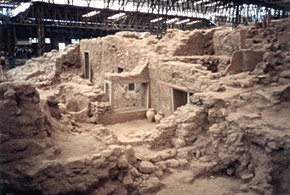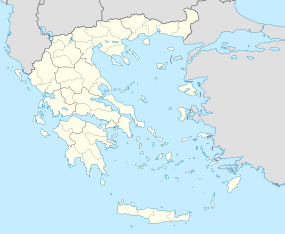Akrotiri (Santorini)

Excavation
|
|
| Location | Santorini, Greece |
|---|---|
| Coordinates | 36°21′05″N 25°24′13″E / 36.35139°N 25.40361°ECoordinates: 36°21′05″N 25°24′13″E / 36.35139°N 25.40361°E |
| Type | Settlement |
| Site notes | |
| Condition | Ruins |
Akrotiri (Greek: Ακρωτήρι, pronounced Greek: [akroˈtiri]) is a Minoan Bronze Age settlement on the volcanic Greek island of Santorini (Thera). The settlement was destroyed in the Theran eruption about 1627 BC and buried in volcanic ash, which preserved the remains of fine frescoes and many objects and artworks. The settlement has been suggested as a possible inspiration for Plato's story of Atlantis. The site has been excavated since 1967.
The earliest evidence for human habitation of Akrotiri can be traced back as early as the fifth millennium BC, when it was a small fishing and farming village. By the end of the third millennium, this community developed and expanded significantly. One factor for Akrotiri’s growth may be the trade relations it established with other cultures in the Aegean, as evidenced in fragments of foreign pottery at the site. Akrotiri’s strategic position on the primary sailing route between Cyprus and Minoan Crete also made it an important point for the copper trade, thus allowing them to become an important center for processing copper, as proven by the discovery of molds and crucibles there.
Akrotiri’s prosperity continued for about another 500 years; paved streets, an extensive drainage system, the production of high quality pottery, and further craft specialization all point to the level of sophistication achieved by the settlement. This all came to an end, however, in the late 17th century BC with the volcanic eruption of Thera.
The Akrotiri excavation site is of a Minoan Bronze Age settlement on the Greek island of Santorini, associated with the Minoan civilization due to inscriptions in Linear A, and close similarities in artifact and fresco styles. The excavation is named for a modern village situated on a hill nearby. The name of the site in antiquity is unknown.
...
Wikipedia

